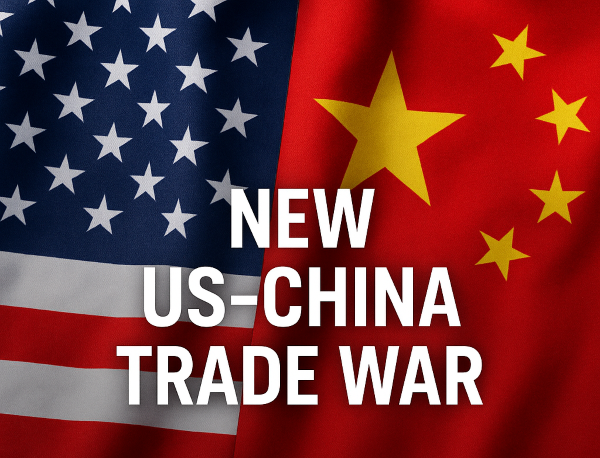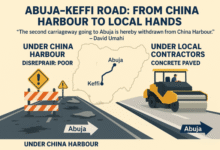
U.S. President Donald Trump has reignited the long-simmering trade war between the United States and China, announcing sweeping new tariffs and export restrictions that threaten to upend global markets and reshape global supply chains once again.
The move ends an uneasy truce between the world’s two largest economies and signals a renewed escalation in their geo-economic rivalry, just weeks before a planned meeting between Trump and Chinese President Xi Jinping in South Korea.
A Shockwave Through Global Trade
In a fiery announcement on Truth Social and during a White House press briefing, President Trump revealed plans to impose 100% tariffs on Chinese exports to the U.S. and introduce export controls on “critical software” by November 1, 2025.
The decision follows Beijing’s recent expansion of rare earth export restrictions — a move Washington views as a direct threat to America’s technology and defense sectors. China currently controls over 90% of the world’s processed rare earth elements, vital for products such as electric vehicles, aircraft engines, smartphones, and military equipment.
“It was shocking,” Trump said. “I thought it was very, very bad. This is a hostile move, and we will respond financially and strategically.”
The White House described Beijing’s restrictions as an “economic provocation,” while Trump termed them “a hostile order,” insisting the U.S. must “counter every element they monopolize.”
Why Rare Earths Matter
Rare earth elements — like neodymium, dysprosium, and lanthanum — are the invisible backbone of the global technology economy. They power everything from AI servers to missile guidance systems.
By curbing exports, Beijing is leveraging one of its most powerful economic weapons, effectively weaponizing minerals that the global economy cannot function without.
Trump’s retaliatory tariffs mark the largest escalation in the trade war since 2019, when both countries imposed hundreds of billions of dollars in reciprocal duties, roiling markets and slowing global trade growth.
Market Reaction: Panic and Volatility
The announcement sent shockwaves across Wall Street. The S&P 500 plunged by 2%, its sharpest one-day fall since April. Tech-heavy indices saw even steeper losses, as investors fled to the safety of gold and U.S. Treasury bonds. The U.S. dollar weakened against major currencies, while commodities prices surged.
Analysts warned that this new US-China Trade War could mark “the beginning of the end” of the fragile tariff truce that stabilized global trade earlier this year.
“Beijing appears to have overplayed its hand,” said Craig Singleton of the Foundation for Defense of Democracies. “Washington sees China’s export curbs as a betrayal of the fragile understanding they reached over the summer.”
China’s Strategic Counter-Move
Beijing’s recent announcement added five new rare earth materials and dozens of refining technologies to its export control list. It also extended compliance obligations to foreign companies using Chinese raw materials, effectively tightening its grip over the global supply chain.
Experts say this move could cripple sectors reliant on Chinese components — from semiconductors to aerospace manufacturing — and increase production costs worldwide.
The Chinese government, while not directly naming the U.S., has maintained that its actions are necessary to “protect national interests and sustainable resource use.”
The Political Dimension
The renewed tariff war comes at a politically sensitive moment. Trump, who is seeking re-election, has repeatedly accused China of “economic sabotage” and vowed to “bring manufacturing back to America.”
The announcement also casts doubt on the upcoming Trump-Xi summit, originally planned for October 31 at the Asia-Pacific Economic Cooperation (APEC) forum in South Korea.
“Now there seems to be no reason to do so,” Trump posted on Truth Social, hinting that the meeting could be canceled.
However, analysts believe both leaders are posturing to gain leverage ahead of any future negotiations.
“They are escalating now to reset the terms of engagement before APEC,” noted Scott Kennedy of the Center for Strategic and International Studies. “Each side is testing how far the other is willing to go.”
Implications for Global Supply Chains
For multinational companies, this escalation spells renewed uncertainty. Many had only begun to recover from the shocks of previous U.S.-China trade disputes and pandemic-era disruptions.
The tech, automotive, and defense industries are expected to feel the brunt of the tariffs and export restrictions brought about by this new phase of the US-China Trade War. U.S. firms reliant on Chinese inputs — from batteries to chips — may face rising costs and supply delays.
The new measures could also trigger a broader realignment of global trade flows, pushing Western companies to source critical minerals from countries like Australia, Canada, and African nations.
Winners and Losers
- Winners: Gold traders, rare-earth producers outside China, and logistics hubs in Southeast Asia may benefit from supply diversification.
- Losers: Tech manufacturers, EV producers, and U.S. consumers who could face higher prices for electronics and vehicles.
- Long-term: Global investors brace for inflationary pressures as production costs rise and trade flows fragment.
The Bigger Picture: Trade, Tech, and Power
At its core, this is no longer a dispute over tariffs alone — it is a strategic power struggle over technology, energy, and influence.
From AI chips to renewable energy technologies, control over critical minerals and software ecosystems has become the new frontier of global competition.
For Washington, the latest escalation in the US-China Trade War aims to reassert U.S. dominance in high-tech sectors and curb China’s march toward self-sufficiency.
For Beijing, it’s about resisting containment and ensuring its economic resilience under pressure.
BRANDECONOMY Insight: A Trade War Redefined
The revival of the U.S.-China trade war signals a new era of economic nationalism, where nations weaponize trade, data, and innovation. The fallout will reverberate across financial markets, supply chains, and global growth prospects.
What began as a tariff dispute has now evolved into a techno-economic Cold War — one that could reshape the 21st-century global economy.
The world watches once again — as tariffs, technology, and trust become the new tools of power.











